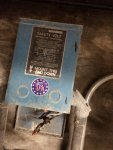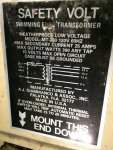I’m having a problem with the low voltage wires for a swimming pool light melting.
I got the call that one light wasn’t working. I got there and one of the splices in the box behind the light was melted. I thought, bad connection, cut the wires back and re-spliced them. A week later and exactly the same splice melted again. This time the other end of the same wire was melted too. The problem is in the 12 volt wires of the circuit. There is no sign of water in the junction boxes.
The system is this:
115 volts in the primary side of the transformer, 12 volts AC on the secondary. 300 watt 12 volt lamp. Primary amps at 2 amps, secondary amps at 20.5. The secondary conductors look like #8 in 3/4” EMT, with insulation that is thick and feels like TW.? The length of the run is about 50’ in the concrete slab. Not in a high heat area.
There are 4 total and the other 3 are fine with specs similar to this one. But the wires are warm to the touch, maybe very warm.
Thanks
Mike
I got the call that one light wasn’t working. I got there and one of the splices in the box behind the light was melted. I thought, bad connection, cut the wires back and re-spliced them. A week later and exactly the same splice melted again. This time the other end of the same wire was melted too. The problem is in the 12 volt wires of the circuit. There is no sign of water in the junction boxes.
The system is this:
115 volts in the primary side of the transformer, 12 volts AC on the secondary. 300 watt 12 volt lamp. Primary amps at 2 amps, secondary amps at 20.5. The secondary conductors look like #8 in 3/4” EMT, with insulation that is thick and feels like TW.? The length of the run is about 50’ in the concrete slab. Not in a high heat area.
There are 4 total and the other 3 are fine with specs similar to this one. But the wires are warm to the touch, maybe very warm.
Thanks
Mike



